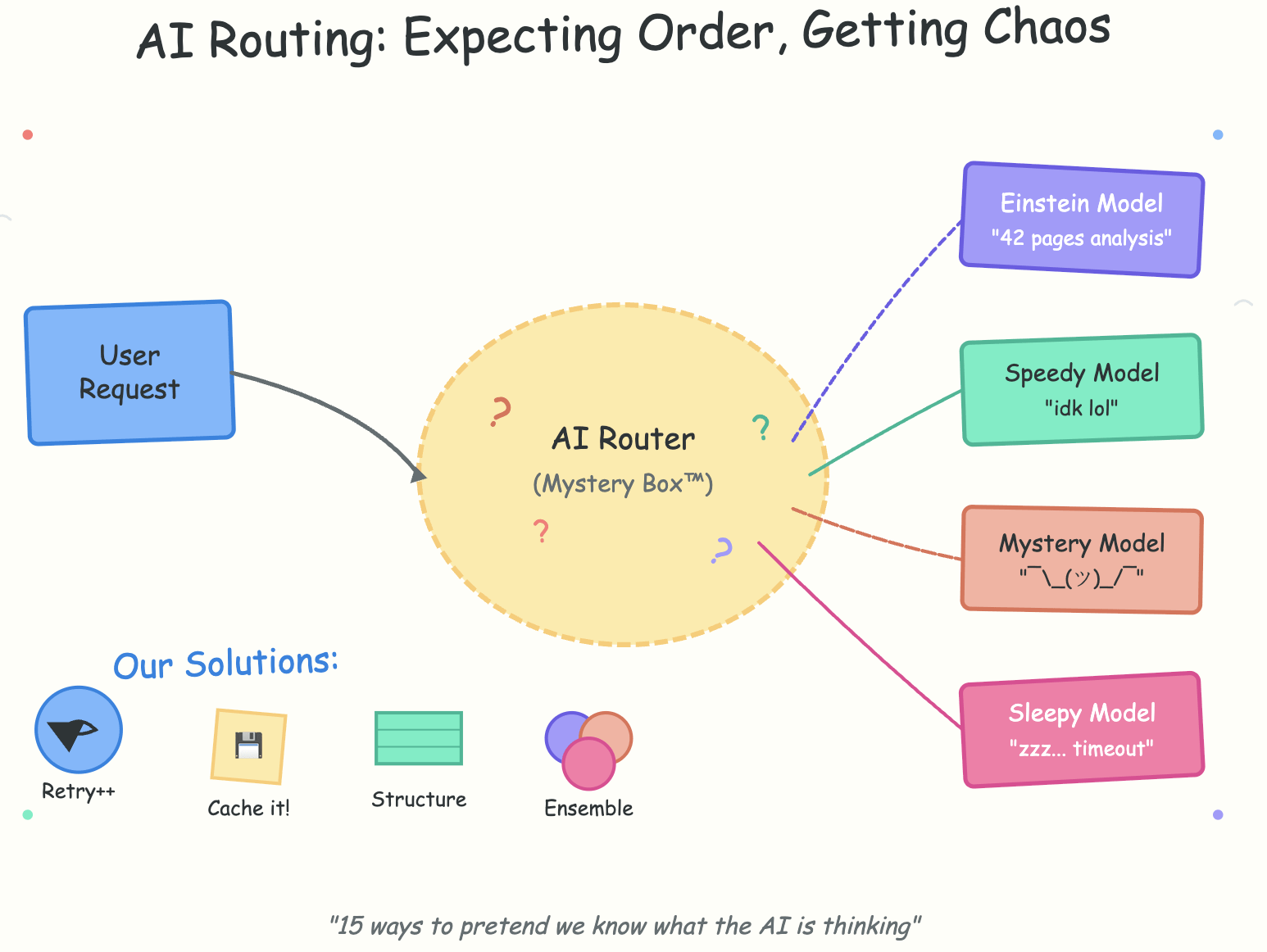
🎯 Takeaways from this compilation:
• We can’t control AI routing, but we can defend against it – Stop fighting the system; build resilience instead
• Never trust a single AI response for critical operations – Multi-shot validation and ensemble approaches are your insurance policy
• Structure is our best friend – Forced JSON schemas and template responses dramatically reduce routing variability
• Cache aggressively, retry intelligently – What worked once will probably work again; store and reuse good responses
• Monitor for model fingerprints – Different models have telltale signs; learn to detect which one you’re talking to
• Break complex prompts into simple chains – Smaller requests are more predictable and easier to debug when routing fails
• Always have a fallback – Circuit breakers, human escalation, and non-AI alternatives keep your system running when routing goes haywire
• Test for chaos, not consistency – Test suites need to handle multiple correct answers, not just one
WARNING
Routing unpredictability isn’t going away. The winners will be teams that build adaptive systems expecting inconsistency, not those waiting for AI providers to fix it.
Immediate Tactical Approaches
1. Prompt engineering for Routing Control
Strategy: Design prompts that explicitly signal desired model behavior
- Specificity Markers: Include clear indicators of complexity level (“simple summary” vs “detailed analysis”)
- Format Constraints: Specify exact output formats (JSON, bullet points, paragraph length)
- Complexity Signals: Use language that hints at the type of processing needed
- Example: Instead of “analyze this data,” use “provide a quick 3-bullet summary” or “perform deep statistical analysis with methodology explanation”
2. Multi-Shot Validation Pattern
Strategy: Run critical requests multiple times and compare outputs
- Implementation: Send the same prompt 3-5 times for important decisions
- Consistency Scoring: Develop metrics to measure output similarity
- Fallback Logic: If outputs vary significantly, flag for human review
- Cost Management: Use this selectively for high-stakes operations only
3. Structured Output Enforcement
Strategy: Force consistent formatting to reduce routing variability
-
JSON Schema: Always request structured JSON responses with defined fields
-
Template Responses: Provide exact templates the AI must fill in
-
Validation Layers: Parse and validate outputs immediately
-
Example: “Respond only in this JSON format:
{ analysis: string, confidence: number, reasoning: string }
Architectural Mitigation Strategies
4. Circuit Breaker Pattern for AI Calls
Strategy: Implement failure detection and automatic fallbacks
- Consistency Monitoring: Track response patterns over time
- Threshold Detection: Automatically detect when routing behavior changes
- Fallback Mechanisms: Switch to alternative models or cached responses
- Recovery Logic: Gradually re-enable primary routing after stability returns
5. Model Ensemble Approach
Strategy: Use multiple AI providers/models and aggregate results
- Provider Diversification: Don’t rely solely on one routing system
- Consensus Building: Compare outputs from different providers
- Weighted Voting: Give more weight to consistently performing models
- Cost Optimization: Use expensive models only for tie-breaking
6. Caching and Memoization
Strategy: Store and reuse consistent outputs to reduce routing exposure
- Semantic Caching: Cache based on prompt meaning, not exact text
- Version Control: Track which model version produced cached results
- Invalidation Strategy: Clear cache when routing behavior changes
- Partial Caching: Cache intermediate results to reduce re-computation
System Design Strategies
7. Abstraction Layer Implementation
Strategy: Build an AI gateway that normalizes routing inconsistencies
- Request Preprocessing: Standardize prompts before sending to AI
- Response Postprocessing: Normalize outputs to consistent formats
- Routing Intelligence: Learn which prompts trigger which models
- Monitoring Dashboard: Track routing patterns and success rates
8. Graceful Degradation Architecture
Strategy: Design systems that function even with inconsistent AI behavior
- Confidence Thresholds: Only use AI outputs above certain confidence levels
- Human-in-the-Loop: Automatic escalation for inconsistent results
- Fallback Workflows: Non-AI alternatives for critical functions
- Progressive Enhancement: Start with simple AI, add complexity gradually
9. Behavioral Fingerprinting
Strategy: Detect which underlying model is responding and adapt accordingly
- Response Pattern Analysis: Learn to identify model signatures
- Adaptive Prompting: Adjust follow-up prompts based on detected model
- Model-Specific Optimization: Tailor requests to specific model strengths
- Routing Prediction: Anticipate which model will be used
Operational Strategies
10. Comprehensive Testing Framework
Strategy: Build testing that accounts for routing variability
- Routing Scenario Testing: Test across different model routing conditions
- Temporal Testing: Test at different times when routing may change
- Load Testing: Understand how routing changes under different loads
- A/B Testing: Compare performance across different prompt strategies
11. Monitoring and Alerting
Strategy: Detect routing changes before they impact users
- Response Time Monitoring: Different models have different latencies
- Output Quality Metrics: Track consistency, accuracy, and format compliance
- Routing Pattern Detection: Alert when routing behavior changes
- User Experience Tracking: Monitor downstream impact of routing changes
12. Documentation and Team Practices
Strategy: Build organizational knowledge about routing behavior
- Routing Playbooks: Document known routing triggers and responses
- Prompt Libraries: Maintain tested prompts with known routing behavior
- Incident Response: Procedures for when routing becomes problematic
- Knowledge Sharing: Regular team reviews of routing discoveries
Advanced Mitigation Techniques
13. Prompt Chaining and Decomposition
Strategy: Break complex requests into smaller, more predictable pieces
- Task Decomposition: Split complex prompts into simpler sub-tasks
- Sequential Processing: Chain simple requests rather than complex ones
- Intermediate Validation: Check outputs at each step
- Rollback Capability: Restart from any point in the chain
14. Model-Specific API Usage
Strategy: When possible, use direct model APIs instead of routing systems
- Direct Model Access: Use specific model endpoints when available
- API Versioning: Pin to specific model versions for consistency
- Custom Fine-tuning: Train models for specific use cases
- Local Model Deployment: Host models locally for full control
15. Adaptive Retry Logic
Strategy: Intelligently retry requests when routing produces poor results
- Quality Assessment: Automatically evaluate response quality
- Smart Retry: Modify prompts slightly on retry to trigger different routing
- Exponential Backoff: Avoid overwhelming systems during routing issues
- Success Pattern Learning: Remember what works and retry with successful patterns
Implementation Priority Matrix
High Impact, Low Effort
- Structured output enforcement
- Multi-shot validation for critical operations
- Basic caching implementation
High Impact, High Effort
- Abstraction layer implementation
- Comprehensive testing framework
- Behavioral fingerprinting
Low Impact, Low Effort
- Documentation improvements
- Basic monitoring setup
- Prompt library creation
Low Impact, High Effort
- Local model deployment
- Custom fine-tuning
- Complex ensemble systems
Key Success Metrics
- Consistency Score: Percentage of identical outputs for identical inputs
- Routing Stability: Frequency of routing pattern changes
- Fallback Activation Rate: How often backup systems engage
- User Experience Impact: Downstream effects on application performance
- Cost Efficiency: Balance between mitigation costs and routing unpredictability costs
The goal isn’t to eliminate routing unpredictability entirely, that’s likely impossible with current AI architectures. Instead, these strategies help build resilient systems that can function effectively despite routing variability, while gradually learning to work with rather than against the underlying routing mechanisms.
